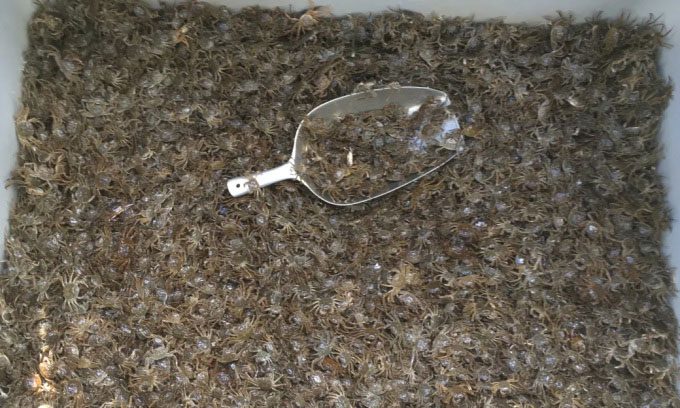Scientists Design Metal Traps Underwater to Catch Chinese Mitten Crabs, One of the Worst Invasive Species in Europe.
Chinese Mitten Crabs (Eriocheir sinensis), also known as Shanghai crabs, are crustaceans native to East Asia, as reported by CNN on January 30. They are characterized by their hairy claws resembling gloves. Their bodies are grayish-blue or dark brown, usually about 8 cm long, but with their legs spread wide, they can reach lengths of up to 25 cm.

A metal channel installed along the riverbed to trap migrating crabs. (Photo: Paul Van Loon)
As one of the 100 worst invasive alien species in the world, Chinese Mitten Crabs are incredibly difficult to control: they eat almost anything, can survive in freshwater, saltwater, and on land, reproduce quickly, with females laying between 250,000 to 1,000,000 eggs at a time.
They were first discovered in Europe over 100 years ago in a river near Bremen, Germany. It appears they arrived from Asia in the ballast water of ships. Since then, the population of Chinese Mitten Crabs has rapidly exploded across Europe. Their negative impacts include disrupting aquatic food chains, spreading fungal diseases in shrimp, and increasing erosion of dikes and riverbanks due to burrowing.
Many European scientists are working to find ways to reduce the number of Mitten Crabs to protect native ecosystems. To date, the most successful strategy has been the metal traps developed by the University of Antwerp and the Flanders Environment Agency in Belgium. Three such traps have been installed in the country since 2018, capturing around 3 million crabs so far, according to Jonas Schoelynck, a professor of aquatic ecology at the University of Antwerp.
The traps consist of a metal channel placed across the river. Crabs enter the channel as they crawl along the riverbed. Unable to swim back out like other aquatic species, they must crawl along the pipe leading to enclosures on either bank. From there, they are collected and processed.
The traps target areas with large populations of migrating crabs. In the fall, adult crabs migrate from freshwater to the sea to spawn, and in the spring, juveniles return from the sea to the river. Schoelynck noted that they can travel remarkable distances, up to 10 km in a day. During this period, Mitten Crabs are frequently encountered. They gather around the mouths of drains or move on land to avoid dams and other obstacles.

So far, approximately 3 million Chinese Mitten Crabs have been captured using metal traps in Belgium. (Photo: Heleen Keirsebelik).
Scientists believe that metal traps are a cost-effective solution. According to Schoelynck, other trapping methods, such as using nets, require more effort and expense. “On an effective day in Belgium, you can catch 80 to 100 crabs with a net. In contrast, with the new type of trap, you can catch 8,000 to 10,000 crabs each day,” he stated, adding that the new traps are less likely to accidentally catch other organisms.
One of the major issues is processing Mitten Crabs after capture. Bjorn Suckow, a scientist at the Alfred Wegener Institute, explained that EU countries have different animal welfare regulations. In Germany, scientists are only permitted to kill crabs by boiling or electrocution. Meanwhile, in Belgium, crabs are frozen in buckets.
Mitten Crabs are a seasonal delicacy in China, but they have little meat and are not favored in the European market, according to Schoelynck. He further explained that many crabs caught are still immature, whereas those consumed as food in China are larger, fully grown specimens. Currently, crabs collected from one of the traps in Belgium are sent to a local zoo to be used as animal feed.


















































